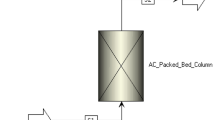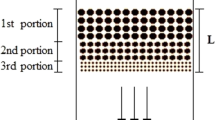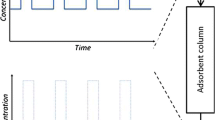Abstract
Adsorptive separation of heavy metals from wastewater is a viable approach to reuse it and avoid environmental pollution. The productive employment of adsorptive separation at a commercial scale, however, relies on the optimized conditions of an adsorber bed holding maximum and selective isolation of the heavy metals. The experimental route includes a significant trial and error approach, is time-consuming, involves operating cost, and remains economically unattractive. Contrarily, simulation of a mathematical model mimicking the adsorption system along with experimental validation can significantly minimize optimization efforts and suggests the best conditions of separation. In this work, a convective-dispersive model and adsorption model for fixed bed adsorption of copper (Cu), chromium (Cr), and cadmium (Cd) metals over wheat bran biosorbent are simulated using the gPROMS tool for benchmarking. The influence of feed flow rate, bed height, and metal concentration is studied, and breakthrough profiles of all heavy metals are predicted and matched with the literature. The error values (R2 and RMSE) and Chi-squared values determined from gPROMS simulations matched well with the previously available MATLAB-simulated data. After a successful benchmarking, we modeled pilot-scale adsorption of Cr on coconut coir (or Biosorbent) in a gPROMS simulation environment. A detailed method and algorithm of gPROMS simulation for Cr isolation is provided. The influence of feed flow rate, bed height, and initial metal concentration is studied on the breakthrough curves of the Cr. The optimum operating condition for the pilot-scale isolation of Cr from the water is suggested. The parameters, such as the axial dispersion coefficient and distribution coefficient, are determined.







Similar content being viewed by others
Data availability
All the necessary data are provided in this manuscript/supporting information.
Abbreviations
- C :
-
Solute concentration in bulk liquid phase
- C 0 :
-
Initial solute concentration in bulk liquid phase
- D L :
-
Axial dispersion coefficient
- k f :
-
External mass transfer coefficient
- K d :
-
Distribution coefficient
- K L :
-
Parameter in Langmuir isotherm
- m :
-
Total dry weight of adsorbent
- m total :
-
Total metal ions passed through column
- Q :
-
Flow rate
- q :
-
Adsorption capacity
- q eq :
-
Adsorption column capacity
- q m :
-
Monolayer capacity of Langmuir isotherm
- q total :
-
Total adsorbed metal ion
- R :
-
Retardation factor
- t :
-
time
- t b :
-
Breakthrough time
- t e :
-
Exhaustion time
- TR:
-
Total removal efficiency
- U 0 :
-
Average approach velocity
- V e :
-
Total volume treated
- z :
-
Bed height
- Z m :
-
Length of mass transfer zone
- ε :
-
Bed voidage
- ρ ads :
-
Density of the particle
- v :
-
Pore velocity
- K Th :
-
Thomas kinetic coefficient
References
Ahamad KU, Jawed M (2012) Breakthrough studies with mono- and binary-metal ion systems comprising of Fe(II) and As(III) using community prepared wooden charcoal packed columns. Desalination 285:345–351. https://doi.org/10.1016/j.desal.2011.10.025
Alalwan HA, Abbas MN, Abudi ZN, Alminshid AH (2018) Adsorption of thallium ion (Tl+3) from aqueous solutions by rice husk in a fixed-bed column: experiment and prediction of breakthrough curves. Environ Technol Innov 12:1–13. https://doi.org/10.1016/j.eti.2018.07.001
Barakat MA (2011) New trends in removing heavy metals from industrial wastewater. Arab J Chem 4:361–377. https://doi.org/10.1016/j.arabjc.2010.07.019
Biswas S, Mishra U (2015) Continuous fixed-bed column study and adsorption modeling: removal of lead ion from aqueous solution by charcoal originated from chemical carbonization of rubber wood sawdust. J Chem 2015:907379–907379. https://doi.org/10.1155/2015/907379
Choi SY, Park KY, Yu Y, Kim HJ, Park KY, Kweon JH, Choe JW (2016) Electrodialysis of groundwater with heavy metal and nitrate ions under low conductivity and effects of superficial velocities. Desalin Water Treat 57:26741–26750. https://doi.org/10.1080/19443994.2016.1190112
Clark RM (1987) Evaluating the cost and performance of field-scale granular activated carbon systems. Environ Sci Technol 21:573–580. https://doi.org/10.1021/es00160a008
Dąbrowski A (2001) Adsorption — from theory to practice. Adv Colloid Interf Sci 93:135–224. https://doi.org/10.1016/S0001-8686(00)00082-8
Díaz-Blancas V, Aguilar-Madera CG, Flores-Cano JV, Leyva-Ramos R, Padilla-Ortega E, Ocampo-Pérez R (2020) Evaluation of mass transfer mechanisms involved during the adsorption of metronidazole on granular activated carbon in fixed bed column. J Water Process Eng 36:101303. https://doi.org/10.1016/j.jwpe.2020.101303
Dorado AD, Gamisans X, Valderrama C, Solé M, Lao C (2014) Cr(III) removal from aqueous solutions: a straightforward model approaching of the adsorption in a fixed-bed column. J Environ Sci Health A 49:179–186. https://doi.org/10.1080/10934529.2013.838855
Du Z, Zheng T, Wang P (2018) Experimental and modelling studies on fixed bed adsorption for Cu(II) removal from aqueous solution by carboxyl modified jute fiber. Powder Technol 338:952–959. https://doi.org/10.1016/j.powtec.2018.06.015
Fallah N, Taghizadeh M (2020) Continuous fixed-bed adsorption of Mo(VI) from aqueous solutions by Mo(VI)-IIP: breakthrough curves analysis and mathematical modeling. J Environ Chem Eng 8:104079. https://doi.org/10.1016/j.jece.2020.104079
Ghasemi M, Keshtkar AR, Dabbagh R, Jaber Safdari S (2011) Biosorption of uranium(VI) from aqueous solutions by Ca-pretreated Cystoseira indica alga: breakthrough curves studies and modeling. J Hazard Mater 189:141–149. https://doi.org/10.1016/j.jhazmat.2011.02.011
Hasan SH, Srivastava P, Talat M (2010) Biosorption of lead using immobilized Aeromonas hydrophila biomass in up flow column system: factorial design for process optimization. J Hazard Mater 177:312–322. https://doi.org/10.1016/j.jhazmat.2009.12.034
Hayati B et al (2018) Heavy metal adsorption using PAMAM/CNT nanocomposite from aqueous solution in batch and continuous fixed bed systems. Chem Eng J 346:258–270. https://doi.org/10.1016/j.cej.2018.03.172
He ZL, Yang XE, Stoffella PJ (2005) Trace elements in agroecosystems and impacts on the environment. J Trace Elem Med Biol 19:125–140. https://doi.org/10.1016/j.jtemb.2005.02.010
Herawati N, Suzuki S, Hayashi K, Rivai IF, Koyama H (2000) Cadmium, copper, and zinc levels in rice and soil of Japan, Indonesia, and China by soil type. Bull Environ Contam Toxicol 64:33–39. https://doi.org/10.1007/s001289910006
Lee C-G, Kim J-H, Kang J-K, Kim S-B, Park S-J, Lee S-H, Choi J-W (2015) Comparative analysis of fixed-bed sorption models using phosphate breakthrough curves in slag filter media. Desalin Water Treat 55:1795–1805. https://doi.org/10.1080/19443994.2014.930698
Malkoc E, Nuhoglu Y, Abali Y (2006) Cr(VI) adsorption by waste acorn of Quercus ithaburensis in fixed beds: Prediction of breakthrough curves. Chem Eng J 119:61–68. https://doi.org/10.1016/j.cej.2006.01.019
Mirbagheri SA, Hosseini SN (2005) Pilot plant investigation on petrochemical wastewater treatmentfor the removal of copper and chromium with the objective of reuse. Desalination 171:85–93. https://doi.org/10.1016/j.desal.2004.03.022
Oh M, Pantelides CC (1996) A modelling and simulation language for combined lumped and distributed parameter systems. Comput Chem Eng 20:611–633. https://doi.org/10.1016/0098-1354(95)00196-4
Patel H (2019) Fixed-bed column adsorption study: a comprehensive review. Appl Water Sci 9:45. https://doi.org/10.1007/s13201-019-0927-7
Renu AM, Singh K (2018) Removal of copper, cadmium, and chromium from wastewater by modified wheat bran using Box–Behnken design: kinetics and isotherm. Sep Sci Technol 53:1476–1489. https://doi.org/10.1080/01496395.2017.1417316
Renu AM, Singh K, Gupta R, Dohare RK (2020) Continuous fixed-bed adsorption of heavy metals using biodegradable adsorbent: modeling and experimental study. J Environ Eng 146:04019110. https://doi.org/10.1061/(ASCE)EE.1943-7870.0001636
Riazi M, Keshtkar A, Moosavian MA (2016a) Biosorption of Th(IV) in a fixed-bed column by Ca-pretreated Cystoseira indica. J Environ Chem Eng 4:1890–1898
Riazi M, Keshtkar AR, Moosavian MA (2016b) Biosorption of Th(IV) in a fixed-bed column by Ca-pretreated Cystoseira indica. J Environ Chem Eng 4:1890–1898. https://doi.org/10.1016/j.jece.2016.03.017
Romero-González J, Walton JC, Peralta-Videa JR, Rodríguez E, Romero J, Gardea-Torresdey JL (2009) Modeling the adsorption of Cr(III) from aqueous solution onto Agave lechuguilla biomass: study of the advective and dispersive transport. J Hazard Mater 161:360–365. https://doi.org/10.1016/j.jhazmat.2008.03.102
Singh DK, Kumar V, Mohan S, Bano D, Hasan SH (2017) Breakthrough curve modeling of graphene oxide aerogel packed fixed bed column for the removal of Cr(VI) from water. J Water Process Eng 18:150–158. https://doi.org/10.1016/j.jwpe.2017.06.011
Sud D, Mahajan G, Kaur MP (2008) Agricultural waste material as potential adsorbent for sequestering heavy metal ions from aqueous solutions – a review. Bioresour Technol 99:6017–6027. https://doi.org/10.1016/j.biortech.2007.11.064
Suksabye P, Thiravetyan P, Nakbanpote W (2008) Column study of chromium(VI) adsorption from electroplating industry by coconut coir pith. J Hazard Mater 160:56–62. https://doi.org/10.1016/j.jhazmat.2008.02.083
Tanvir MS, Mujtaba IM (2008) Optimisation of design and operation of MSF desalination process using MINLP technique in gPROMS. Desalination 222:419–430. https://doi.org/10.1016/j.desal.2007.02.068
Thaore VB, Dicholkar DD, Gaikar VG (2017) Steam pyrolysis of tetrabutyldiglycolamide: part-II: reaction network kinetic modelling. J Anal Appl Pyrolysis 123:173–183. https://doi.org/10.1016/j.jaap.2016.12.008
Tripp AR, Clifford DA (2006) Ion exchange for the remediation of perchlorate-contaminated drinking water. J AWWA 98:105–114. https://doi.org/10.1002/j.1551-8833.2006.tb07638.x
Wan Ngah WS, Teong LC, Toh RH, Hanafiah MAKM (2012) Utilization of chitosan–zeolite composite in the removal of Cu(II) from aqueous solution: adsorption, desorption and fixed bed column studies. Chem Eng J 209:46–53. https://doi.org/10.1016/j.cej.2012.07.116
Yoon YH, Nelson JH (1984) Application of gas adsorption kinetics. I. A theoretical model for respirator cartridge service life. Am Ind Hyg Assoc J 45:509–516. https://doi.org/10.1080/15298668491400197
Yusuf M, Song K, Li L (2020) Fixed bed column and artificial neural network model to predict heavy metals adsorption dynamic on surfactant decorated graphene. Colloids Surf A Physicochem Eng Asp 585:124076. https://doi.org/10.1016/j.colsurfa.2019.124076
Zhang Y, Duan X (2020) Chemical precipitation of heavy metals from wastewater by using the synthetical magnesium hydroxy carbonate. Water Sci Technol 81:1130–1136. https://doi.org/10.2166/wst.2020.208
Zolotarev PP, Ugrozov VV, Volkina IB, Nikulin VM (1994) Treatment of waste water for removing heavy metals by membrane distillation. J Hazard Mater 37:77–82. https://doi.org/10.1016/0304-3894(94)85035-6
Funding
This study has the financial assistance from University Grant Commission under the Non-NET scheme, and the financial support through TEQIP-III scheme (Government of India project assisted by World Bank) at Z.H. College of Engg. & Technology, AMU from Ministry of Human Resource Development.
Author information
Authors and Affiliations
Contributions
Mohd Danish: gRPOMS-driven modeling of heavy metal adsorption, initial draft preparation; Khursheed B. Ansari: conceptualization, draft editing, and revision; Rameez Ahmad Aftab: modeling work and drafting of the manuscript; Mohammad Danish: concept, visualization, and Supervision; Sadaf Zaidi: suggestions on manuscript and visualization; Quang Thang Trinh: modeling inputs, final drafting, and proofreading.
Corresponding author
Ethics declarations
Competing interests
The authors declare that they have no competing interests.
Additional information
Responsible editor: Tito Roberto Cadaval Jr
Publisher’s note
Springer Nature remains neutral with regard to jurisdictional claims in published maps and institutional affiliations.
Publisher’s note
Springer Nature remains neutral with regard to jurisdictional claims in published maps and institutional affiliations.
Supplementary Information
ESM 1
(DOCX 21 kb)
Rights and permissions
About this article
Cite this article
Danish, M., Ansari, K.B., Aftab, R.A. et al. gPROMS-driven modeling and simulation of fixed bed adsorption of heavy metals on a biosorbent: benchmarking and case study. Environ Sci Pollut Res 30, 71511–71526 (2023). https://doi.org/10.1007/s11356-021-13207-y
Received:
Accepted:
Published:
Issue Date:
DOI: https://doi.org/10.1007/s11356-021-13207-y




